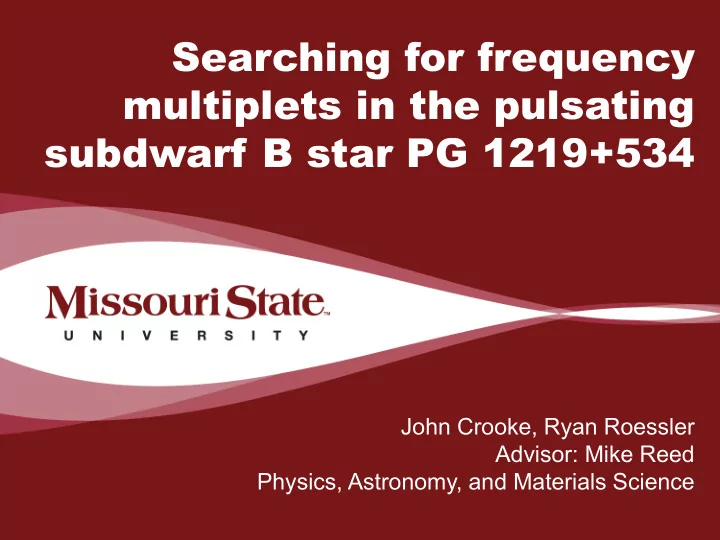

Searching for frequency multiplets in the pulsating subdwarf B star PG 1219+534 John Crooke, Ryan Roessler Advisor: Mike Reed Physics, Astronomy, and Materials Science | | 0 4/22/2017 Physics, Astronomy, and Materials Science
Asteroseismology • Study of pulsations to g-modes infer internal structure • Only way to “observe” the inside of a star • Two oscillation modes • p: pressure mode, high frequency • g: gravity mode, low frequency p-modes | | 1 4/22/2017 Physics, Astronomy, and Materials Science
Asteroseismology m= 0 1 2 3 4 • Using frequency multiplets (rotation period), it is 0 possible to remove azimuthal degeneracy and associate pulsations with 1 spherical harmonics l= 2 • Angular degree: l • # of nodal lines • Azimuthal order: m 3 • # of nodal lines crossing equator • Radial order: n 4 • # of nodal lines along radius | | 2 4/22/2017 Physics, Astronomy, and Materials Science
Subdwarf B (sdB) stars • 0.5 M sun , 0.2 R sun • 20,000 – 30,000 K • Horizontal Branch • post helium-flash • Thin, inert envelopes 1 • Helium fusing cores | | 3 4/22/2017 Physics, Astronomy, and Materials Science
Previous Work on PG1219+534 • Four dominant • Frequency multiplets pulsation frequencies 2 indicating rotation period of ~35 days 3 • 6721 μHZ , 148.8 seconds • No evidence or data • 6961 μHZ , 143.7 seconds published • 7590 μHZ , 131.8 seconds • Goal of project is to • 7807 μHZ , 128.1 seconds find evidence of this rotation | | 4 4/22/2017 Physics, Astronomy, and Materials Science
Observations • January-August 2015, Baker Observatory • Baker Observatory Robotic Autonomous Telescope (BORAT) • 16-inch Schmidt-Cassegrain with Apogee U47 CCD • 44 nights processed (28 usable), 125 hours of images total | | 5 4/22/2017 Physics, Astronomy, and Materials Science
Analysis Sample lightcurve and Fourier Transform from March 31, 2015 | | 6 4/22/2017 Physics, Astronomy, and Materials Science
Analysis 6961 7807 7590 6721 | | 7 4/22/2017 Physics, Astronomy, and Materials Science
Analysis • Close-up view of dominant frequencies • Blue lines have 0.3 μ Hz separation • Not consistent • Green and red show that structure is not evenly split | | 8 4/22/2017 Physics, Astronomy, and Materials Science
Conclusions • Recovered three of four reported frequencies, fourth at low amplitude • Do not see frequency multiplets indicating reported rotation period of 35 days • Should see it, data spans 160 days • Have shown BORAT works for asteroseismology but with data density issues | | 9 4/22/2017 Physics, Astronomy, and Materials Science
References / Acknowledgements 1. Heber, U., 2016, PASP, 128, 2001. 2. Reed, M., et al., 2013, A&A. 3. Fontaine, G., et al., 2014 ASPC, 481, 19. _______________________________________________________ Funding for this research was provided by the National Science Foundation grant #1312869. Any opinions, findings, and conclusions or recommendations expressed in this material are those of the author(s) and do not necessarily reflect the views of the National Science Foundation. Mr. Crooke was supported by the Missouri Space Grant Consortium, funded by NASA. | | 10 4/22/2017 Physics, Astronomy, and Materials Science
Recommend
More recommend